The Exhibition of the Yokohama Museum of Art: Collection 2015 Part2
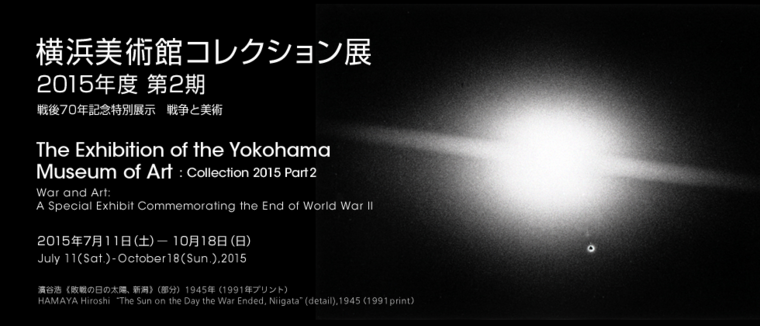
HAMAYA Hiroshi "The Sun on the Day the War Ended, Niigata" (detail) 1945 (1991 print)
Highlight
War and Art: A Special Exhibit Commemorating the End of World War II
OKAKURA Tenshin and the Artists of the Nihon Bijutsuin
Paul JACOULET and the New Print Movement
This exhibition of works from the museum collection, which coincides with the 70th anniversary of the end of World War II, considers the relationship between war and art.
A variety of avant-garde trends emerged against a backdrop of social unrest in Europe between the First and Second World Wars. Meanwhile in Japan, which had already seen the rise of new art movements in the Taisho Period (1912-1926), a unique style of avant-garde art was born after Japanese painters came into contact with new forms of expression such as Surrealism in the pre-war Showa Period (1926-1940). Gradually, however, these activities became a target of government suppression, and with the outbreak of war, they were suspended by the Imperial Rule Assistance Association. After the war, artists went back to work as reconstruction efforts moved forward in society as a whole. This required a resolve to start over from scratch and explore new forms of expression while struggling with mental scars that were still fresh from the war. These experiences, which the artists had been unwillingly burdened with, displayed an ongoing influence, both direct and indirect, in their work. In this special exhibit, we introduce art by artists working in a variety of genres who lived around the time of the war by drawing on the museum’s collection of 20th century art. We also present reference materials such as photographs, magazines, and books in order to reexamine the relationship between art and war in Europe, and above all, in Japan.
To coincide with the “Cai Guo-Qiang: There and Back Again” exhibition, we present a sampling of modern Nihon-ga, a genre that Cai is deeply interested in. Drawing on the special characteristics of the museum collection, this exhibit consists of works by Nihon-ga painters such as YOKOYAMA Taikan, SHIMOMURA Kanzan, IMAMURA Shiko, and YASUDA Yukihiko, all of whom were taught by OKAKURA Tenshin.
In addition, there is a display of work by the Paris-born ukiyo-e artist Paul JACOULET (1896-1960). The Shin Hanga (New Print) movement set out to revive and modernize ukiyo-e, which by that point had fallen into decline. In this exhibit, we present important prints from our collection of 188 works by JACOULET, who held a special place in the movement, along with other examples of new prints by HASHIGUCHI Goyo, ITO Shinsui, and others.
■The Exhibition of the Yokohama Museum of Art : Collection 2015 Part 2
List of works [809KB]
1. War and Art: A Special Exhibit Commemorating the End of World War II
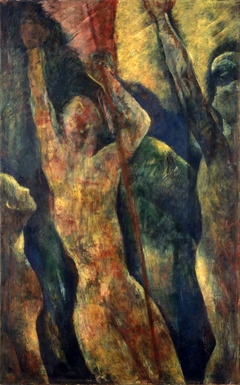
KAWAGUCHI Kigai “A Group” 1941 (Donated by KAWAGUCHI Kyoson)
Disquieting Landscapes: Avant-garde Art and Photography from the 1920s to World War II
Dada, Surrealism, New Objectivity, Constructivism – a variety of avant-garde art movements emerged against a backdrop of disquieting social conditions in Europe after World War I. With the outbreak of World War II, many avant-garde artists took refuge in the U.S. and other countries.
The Japanese art world saw the rise of trends rooted in the new art movements of the Taisho era such as proletarian art, which advocated revolution through art based on socialist principles, Fauvism, introduced by SATOMI Katsuzo, SAEKI Yuzo and others upon their return from France, and Surrealism, which centered on FUKUZAWA Ichiro. Before long, however, art deemed “avant-garde” became the target of government suppression and the artists were soon forced to stop working. As part of the support system that emerged with the outbreak of war, many painters, including FUJITA Tsuguharu, OGAWARA Shu, and SHIMIZU Toshi served the nation by making “war pictures.”
In this section, focusing on the rise and fall of avant-garde art movements in Japan between the two world wars, we trace these developments through documentary photographs published by Nippon Kobo, an agency overseen by NATORI Yonosuke, and photographs of the landscape and local customs in Tokyo during the period by artists such as NAKAGAWA Kazuo and MOROOKA Koji.
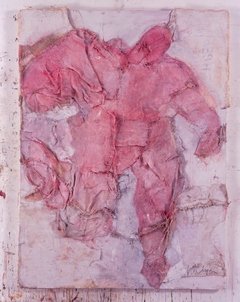
MIYAZAKI Shin “Dance of the Spirit” 2001 (Donated by the Artist)
Out of the Ashes: Memories and Scars of War in Japanese Postwar Art
On August 15, 1945, the end of the war was announced in a radio broadcast by the Showa emperor. When HAMAYA Hiroshi learned of Japan’s defeat while staying in Takada (now Joetsu, Niigata Prefecture), where he had evacuated during the conflict, he ran out of his house and aimed his camera at the midsummer sun floating in the wide open sky.
Many young painters were deeply scarred by their experiences and memories of the war. After returning to Japan, KITAOKA Fumio, who had been in Manchuria when the conflict ended, produced a series of prints based on his memories of escaping the harsh conditions in China with his wife and newly born daughter in tow. Other artists, like HAMADA Chimei and MIYAZAKI Shin, who had miraculously returned from the Chinese front alive, internalized what they had witnessed in POW camps and in battle, and repeatedly depicted their experiences in their work.
Even when the scars of war seemed to have been buried in the ashes, they cast a dark shadow over people’s lives. As the first Japanese city to receive Allied Forces and the starting point for the postwar era, Yokohama embodied the realities of occupation and the realization of reconstruction. OKUMURA Taiko and Tokiwa Toyoko, who began working as photographers during this turbulent period, were among the first to capture the vivid landscapes and local customs of occupied Yokohama.
In this section, we introduce works by painters and photographers who recorded memories of the things they experienced and suffered during and after the war to ensure that the misery and folly of war would never be forgotten.
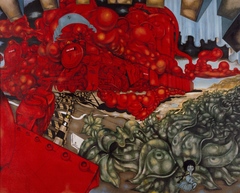
NAKAMURA Hiroshi "Sightseeing Empire" 1964
Revisiting the Avant-garde: New Developments in Japanese Postwar Art
After being squelched by the war, a new group of avant-garde artists emerged after the conflict with a strong resolve to create expressions from scratch. Believing that creating art was a free act and an expression of the individual spirit, YOSHIHARA Jiro formed the Gutai Art Association with a group of young artists in the Kansai region in 1954. The artists pursued a wide range of experimental activities. SHIRAGA Kazuo, for example, painted with his feet and MOTONAGA Sadamasa used a free-flowing technique to make pictures. With an emphasis on spontaneity and the unrestricted selection of materials, a wide range of artists emerged from Gutai.
At the same time, DOMOTO Hisao, a Paris-based painter affiliated with Art Informel, urged the movement’s leading proponent, Michel Tapié, to travel to Japan in 1957. Tapié’s visit lead to what became known as an “Informel whirlwind” in the Japanese art world, and the same year the Yomiuri Independent exhibition began to attract artists who were determined out to explore new expressions, including important figures in avant-garde art of the ‘60s such as SHINOHARA Ushio and NAKANISHI Natsuyuki.
YANAGI Yukinori’s "Hinomaru (Japanese National Flag)"(1991), displayed at the end of “War and Art,” was created out of hundreds of stamps with Japanese surnames carved in them. As a nation, Japan plunged into war. Here we see the names of countless ordinary Japanese people who collectively make up the nation. The work urges us to consider the relationship between war, the state, and the Japanese people.
2. OKAKURA Tenshin and the Artists of the Nihon Bijutsuin
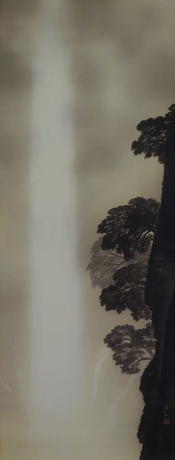
YOKOYAMA Taikan "Clouds of Waterfall Spray" 1927
Inspired by alumni such as Taikan, second-generation Nihon Bijutsuin students like YASUDA Yukihiko and IMAMURA Shiko were hailed in the art world for their innovative work. These early examples of New Nan-ga were distinguished by an eagerness to reinterpret existing subjects and adopt the techniques and openness of Nan-ga (a style derived from the Southern school of Chinese painting). Though temporarily faced with management difficulties, the Nihon Bijutsuin was revived immediately after Okakura’s death, continuing to function as a base for Taikan and other leading proponents of modern Japanese painting. In addition, by carrying on Okakura’s concentrated efforts to revive wooden sculpture, a sculpture department was added to the school and HIRAGUSHI Denchu and others helped the media prosper.
The Cai Guo-Qiang: There and Back Again exhibition, currently underway at the museum, includes some of Cai’s new gunpowder paintings, inspired by Taikan’s Nihon-ga and the work of other artists who were educated by Okakura.
3. Paul JACOULET and the New Print Movement
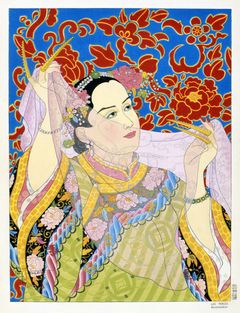
Paul JACOULET "The Pearls, China"
©ADAGP, Paris & JASPAR, Tokyo, 2015 C0653
After his father accepted a post as a French instructor in Japan, Paris-born Paul JACOULET (1896-1960) came to the country with his mother at the age of three. At 11, he developed a strong interest in ukiyo-e, and studied with a husband-and-wife team of Nihon-ga painters named IKEDA Terukata and Shoen. This led to JACOULET’s own hand-painted ukiyo-e works. Encouraged by ukiyo-e scholar FUJIKAKE Shizuya to publish multicolored woodblock prints based on watercolor paintings depicting foreign models, JACOULET began making prints in conjunction with a carver and printer. And by researching unique local customs on trips to Korea and Micronesia, depicting human forms with the okubi-e (“large head”) format, and even creating transparent figures on cloth, JACOULET developed a peculiar new realm in the lineage of new prints, adopting innovative approaches both in terms of subject matter and technique.
In this exhibit, we present representative pictures from the museum’s collection of 188 JACOULET works along with those other artists associated with the New Print movement such as HASHIGUCHI Goyo and ITO Shinsui.
4. Foyer, Grand Gallery:Isamu NOGUCHI and Sculptures in the 20th Century
Outline
| Dates | July 11 (Sat.)-October 18 (Sun.), 2015 |
|---|---|
| Closed | Thursdays |
| Open Hours | 10:00-18:00 (admission until 17:30) *Evening hours: September 16 (Wed.), September 18 (Fri.) 10:00-20:00 (admission until 19:30) |
| Organizer | Yokohama Museum of Art |
Ticket
| Adults | 500 (400) |
|---|---|
| University students High school students | 300 (240) |
| Junior high school students | 100 (80) |
| Children under 12 | Free |
*( )= Group of over 20 people (pre-booking required)
*Admission for high school and younger student is free every Saturday.
(Student ID or student handbook required)
*Visitors with disability and one person accompanying them are admitted free of charge.
(Please present certificate at the admission.)
*Collection gallery is available with ticket of Special Exhibition.









